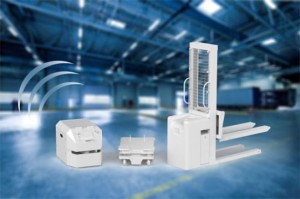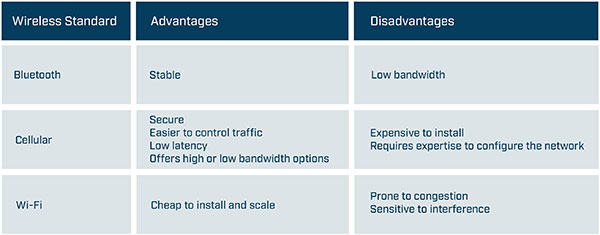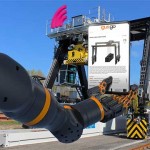Communication and safety challenges with AMRs
 To work efficiently, mobile robots need safe and reliable communication. The experts at HMS Networks outline the main communication and safety challenges, and provide an easy way to overcome these challenges to keep mobile robots moving.
To work efficiently, mobile robots need safe and reliable communication. The experts at HMS Networks outline the main communication and safety challenges, and provide an easy way to overcome these challenges to keep mobile robots moving.
Mobile robots transport materials from one location to another and come in two types, automated guided vehicles (AGVs) and autonomous mobile robots (AMRs). AGVs use guiding infrastructure (wires reflectors, reflectors, or magnetic strips) to follow predetermined routes. If an object blocks an AGV’s path, the AGV stops and waits until the object is removed.
AMRs are more dynamic. They navigate via maps and use data from cameras, built-in sensors, or laser scanners to detect their surroundings and choose the most efficient route. If an object blocks an AMR’s planned route, it selects another route. As AMRs are not reliant on guiding infrastructure, they’re quicker to install and can adapt to logistical changes.
There are, however, a number of communication and safety challenges in the use of mobile robots:
1. Establish a wireless connection
The first challenge is to select the most suitable wireless technology. The usual advice is to establish the requirements, evaluate the standards, and choose the best match. Sometimes a Bluetooth connection will be ideal as it offers a stable non-congested connection, while other applications will require a high-speed, secure cellular connection.
The second challenge is to ensure that the installation works as planned. Before installing a wireless solution, complete a predictive site survey based on facility drawings to ensure the mobile robots have sufficient signal coverage throughout the location. The site survey should identify the optimal location for the access points, the correct antenna type, the optimal antenna angle, and how to mitigate interference. After the installation, use wireless sniffer tools to check the design and adjust APs or antenna as required.
2. Connecting to industrial networks
Mobile robots need to communicate with controllers at the relevant site even though the mobile robots and controllers are often using different industrial protocols. For example, an AGV might use CANopen while the controller might use Profinet. Furthermore, it might be desirable to use the same AGV model on a different site where the controller uses another industrial network, such as EtherCAT.
Mobile robots need to have sufficient capacity to process the required amount of data, which will vary depending on the size and type of installation. Large installations may use more data as the routing algorithms need to cover a larger area, more vehicles, and more potential routes. Navigation systems such as vision navigation process images and therefore require more processing power than installations using other navigation systems such as reflectors. This leads to a number of challenges:
- The networking technology needs to support all major fieldbus and industrial Ethernet networks.
- It needs to be easy to change the networking technology to enable the mobile robot to communicate on the same industrial network as the controller without changing the hardware design.
- The networking technology must have sufficient capacity and functionality to process the required data.
3. Creating a safe system
Creating a system where mobile robots can safely transport material is a critical but challenging task. The system needs to consider all the diverse types of mobile robots, structures, and people in the environment. The mobile robots need to be able to react to outside actions, such as someone opening a safety door or pushing an emergency stop button, and that the networking solution can process different safety protocols and interfaces.
AMRs move freely, so the risk of collisions must be managed accordingly. The technology used in sensors is constantly evolving, while the safety standards provide guidelines on implementing safety-related components, preparing the environment and maintaining machines or equipment.
While compliance with the different safety standards (ISO, DIN, IEC, ANSI, etc) is mostly voluntary, machine builders in the European Union are legally required to follow the safety standards in the machinery directives. Machinery directive 2006/42/EC is always applicable for mobile robots, and in some applications, directive 2014/30/EU might also be relevant as it regulates the electromagnetic compatibility of equipment.
Although the other safety standards are not mandatory, they should still be followed as they help to fulfil the requirements in machinery directive 2006/42/EC. For example, the guidance in ISO 12100 can be used to reduce identified risks to an acceptable residual risk. ISO 13849 or IEC 62061 can be used to find the required safety level for each risk and ensure that the corresponding safety-related function meets the defined requirements.
As examples of how certain safety levels can be achieved, decreasing the speed of the mobile robot can lower the risk of collisions and severity of injuries to an acceptable level. Or mobile robots can operate only in separated zones where human access is prohibited (defined as confined zones in ISO 3691-4).
Identifying the correct standards and implementing the requirements is the best way to create a safe system. But as this summary suggests, it’s a complicated and time-consuming process.
4. Ensuring a reliable CAN communication
A reliable and easy-to-implement standard since the 1980s, communication-based on CAN technology is still growing in popularity. CAN is simple, energy and cost-efficient. All the devices on the network can access all the information, and it’s an open standard, meaning that users can adapt and extend the messages to meet their needs.
In the use of mobile robots, establishing a CAN connection enables monitoring of the lithium-ion batteries increasingly used in the drive systems, either in retrofit systems or in new installations.
5. Accessing mobile robots remotely
The ability to remotely access a machine’s control system can enable mobile robot engineers to troubleshoot and resolve most problems without traveling to the site. The challenge is to create a remote access solution that balances the needs of the IT department with the needs of the engineer.
The IT department wants to ensure that the network remains secure, reliable, and retains integrity. As a result, the remote access solution should include the following security measures:
- Use outbound connections rather than inbound connections to keep the impact on the firewall to a minimum.
- Separate the relevant traffic from the rest of the network.
- Encrypt and protect all traffic to ensure its confidentiality and integrity.
- Ensure that vendors work in line with or are certified to relevant security standards such as ISO 27001
- Ensure that suppliers complete regular security audits.
The engineer wants an easy-to-use and dependable system. It should be easy for users to connect to the mobile robots and access the required information. If the installation might change, it should be easy to scale the number of robots as required. If the mobile robots are in a different country from the vendors or engineers, the networking infrastructure must have sufficient coverage and redundancy to guarantee availability worldwide.
As we’ve seen, mobile robot installations involve many communication and safety challenges. Enlisting purpose-built third-party communication solutions such as those provided by HMS Networks not only solves the communication challenges at hand, it also provides other benefits.
Visit the HMS Industrial Networks website for more information
See all stories for HMS Industrial Networks
















